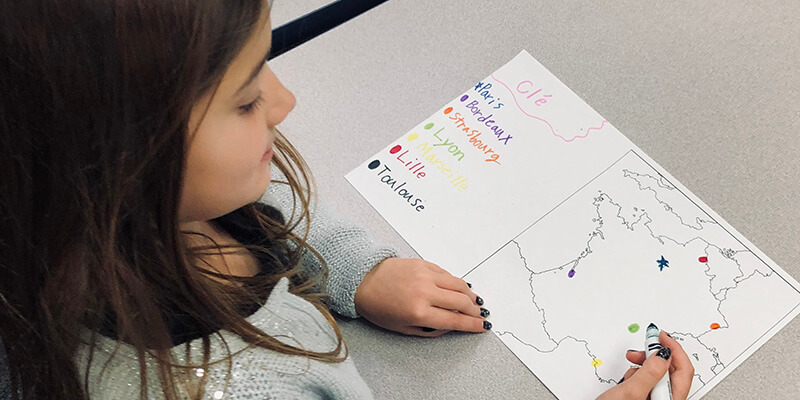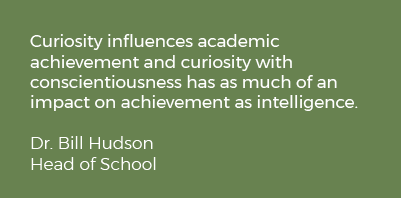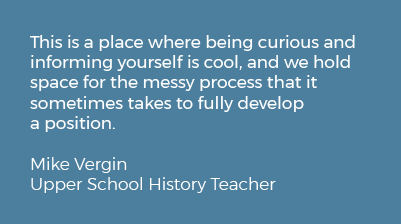May 15, 2019
 by Dr. Bill Hudson, Head of School, Mounds Park Academy
by Dr. Bill Hudson, Head of School, Mounds Park Academy
I came across an article recently shared by Entrepreneur magazine entitled, “The Most Important Skill at the Office Isn’t Being Taught in School.” It caught my attention. What is that important skill? The article argues it is curiosity. Curiosity is named by many behavioral scientists to be among the most valuable attributes in the workplace and yet it is not fostered in many schools. In fact, the way in which schools are structured discourages it—so many schools are driven by standardized testing and measure performance solely on test-based standards. Rest assured that is not the case at Mounds Park Academy in St. Paul, and in fact, is quite the opposite of our approach.
At MPA, curiosity is not just encouraged, it is expected. Furthermore, curiosity is valued as a mindset to be cultivated in its own right, not just for the workplace, but for lifelong fulfillment. According to best-selling author Todd Kashdan, “Curiosity—a state of active interest or genuinely wanting to know more about something—creates an openness to unfamiliar experiences, laying the groundwork for greater opportunities to experience discovery, joy, and delight.” Whether in the classroom, the workplace, or in life, curiosity is essential.
 There are many ways that teachers at MPA cultivate curiosity. For example, Lower School French teacher Liz DesLauriers values the freedom to “twist and turn the curriculum” to follow the lead of her students. “If a particular group seems curious about something, I will change up my plan and tailor it to what they are interested in. For example, I have a group right now that seems particularly interested in the geography of France. It was only mentioned briefly in a lesson, but they showed curiosity and interest in it so I’m going to head in that direction. We are now making maps and discussing different cities and landmarks using our French vocabulary.” Ms. DesLauriers will guide the children to achieve the same learning objectives she had originally intended, but to do that she is following the natural curiosity of her students in a way that fuels their passion.
There are many ways that teachers at MPA cultivate curiosity. For example, Lower School French teacher Liz DesLauriers values the freedom to “twist and turn the curriculum” to follow the lead of her students. “If a particular group seems curious about something, I will change up my plan and tailor it to what they are interested in. For example, I have a group right now that seems particularly interested in the geography of France. It was only mentioned briefly in a lesson, but they showed curiosity and interest in it so I’m going to head in that direction. We are now making maps and discussing different cities and landmarks using our French vocabulary.” Ms. DesLauriers will guide the children to achieve the same learning objectives she had originally intended, but to do that she is following the natural curiosity of her students in a way that fuels their passion.
 Writing for the Harvard Business Review, behavioral scientist Francesca Gino points to research that shows an increase in curiosity leads to an increase in creativity. In turn, creativity leads to innovation and the ability to discover better solutions to problems. There is also a link between curiosity and critical thinking, communication, collaboration, and problem-solving. A meta-analysis of more than 200 studies found that curiosity influences academic achievement and curiosity with conscientiousness has as much of an impact on achievement as intelligence.
Writing for the Harvard Business Review, behavioral scientist Francesca Gino points to research that shows an increase in curiosity leads to an increase in creativity. In turn, creativity leads to innovation and the ability to discover better solutions to problems. There is also a link between curiosity and critical thinking, communication, collaboration, and problem-solving. A meta-analysis of more than 200 studies found that curiosity influences academic achievement and curiosity with conscientiousness has as much of an impact on achievement as intelligence.
“At MPA, you can disagree, you can evolve your thinking, and you can question your original stance,” says Upper School history teacher Mike Vergin. “This is a place where being curious and informing yourself is cool, and we hold space for the messy process that it sometimes takes to fully develop a position.” Asking questions, working together as a group to think critically about a topic, and listening to the perspectives of others, are all integral aspects of curiosity. Teachers at MPA work very hard and deliberately to create an environment that fosters curiosity so that solutions to problems can be approached creatively and innovatively.
 According to leadership consultant Simon Walker, “The biggest killer to curiosity is assuming you know enough.” Even one of our most knowledgeable and experienced teachers, Middle School math teacher Dan Ethier, admits that he doesn’t always have the answer and actively shares that with his students.
According to leadership consultant Simon Walker, “The biggest killer to curiosity is assuming you know enough.” Even one of our most knowledgeable and experienced teachers, Middle School math teacher Dan Ethier, admits that he doesn’t always have the answer and actively shares that with his students.
“Students ask good questions. I try to be willing to spend some time pursuing those questions and demonstrating sincere interest in them. Sometimes I raise the questions myself. Today in geometry, there was a problem that asked what you get when you draw all the points that are equidistant from two intersecting lines. The official answer is that you get their angle bisectors. But in the drawing, it looked like those angle bisectors were perpendicular. I asked if they thought that was true. I think it’s true, but I’m not sure. But I’d kind of like to know. So sometimes it’s being curious myself and letting that spill over into the lesson.” Curiosity is contagious.
I remember a conversation I had with a parent several years ago. He was telling me about his work in computer programming and the success he has found in it. The more he explained to me what he did, the more I thought he was going to tell me that MPA needed more science, more math, more coding. Instead, he surprised me by saying that his family chose MPA because of the balance we maintain between the humanities and sciences. In fact, he thought that instead of balancing the two, MPA did an excellent job of interweaving the arts in the sciences and vice versa.
Curiosity is at the heart of challenging students to dream big and do right. It is through curiosity that MPA students learn to approach their studies, and life, with creativity. They learn to ask the big questions that inspire big dreams. They develop the confidence to tackle problems in the face of uncertainty, harness curiosity to drive innovation, and to do right at a time when it is needed most.
Mounds Park Academy, a PreK-12 private school in Saint Paul, is currently accepting applications for the 2019-20 school year. We look forward to getting to know your family!